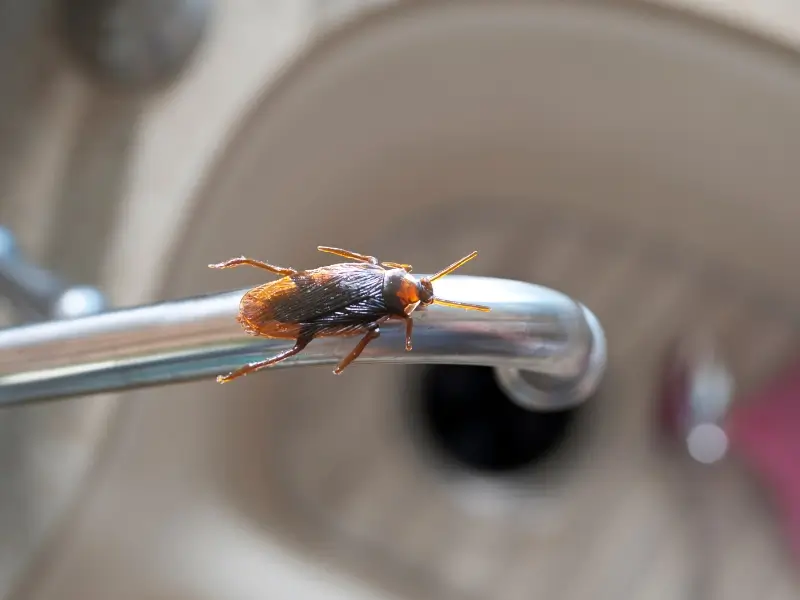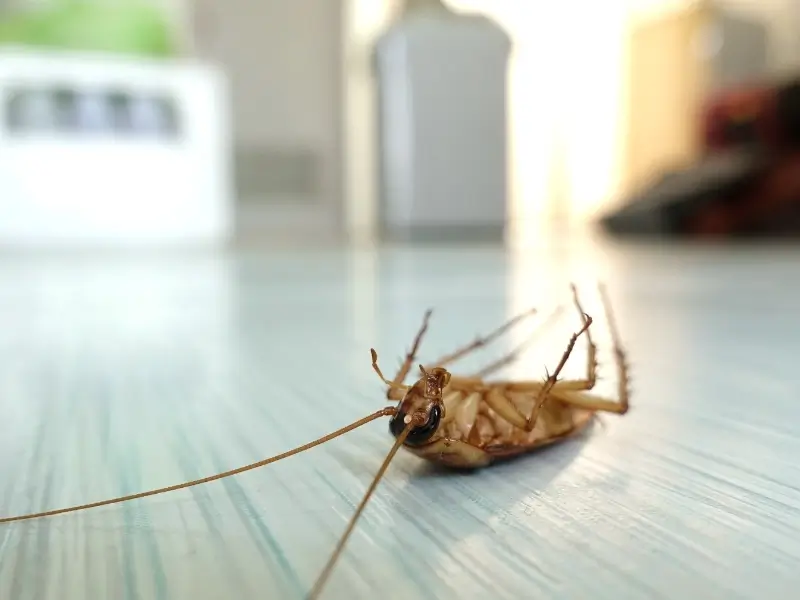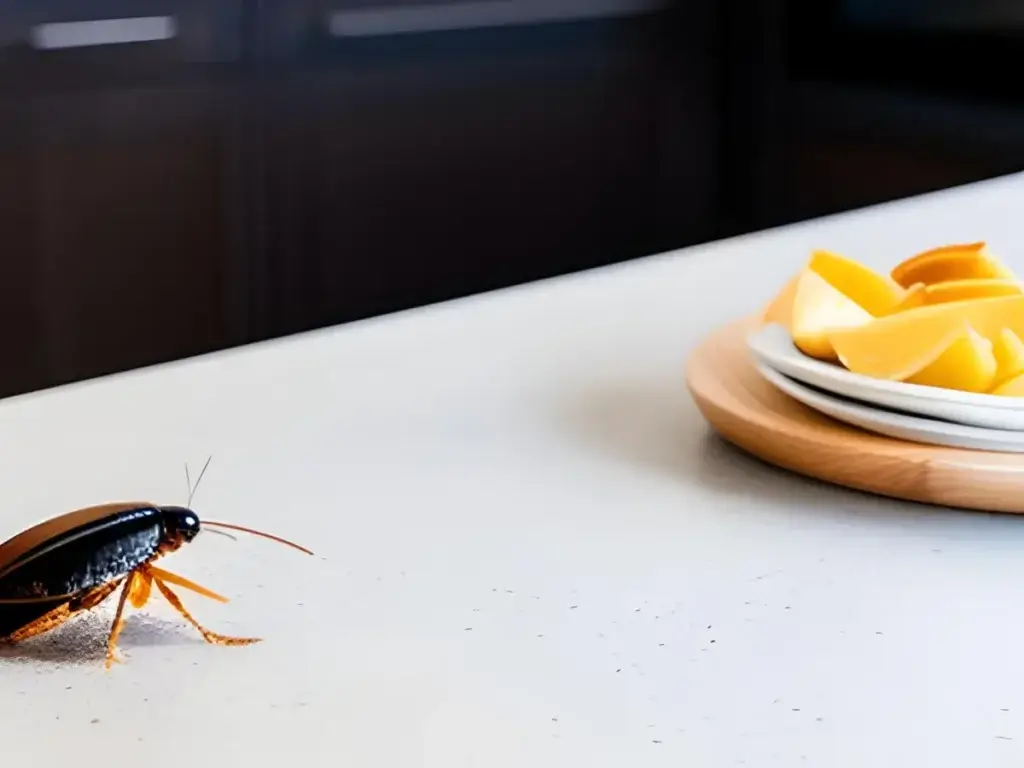
What Diseases Do Cockroaches Carry?
If you hear something scuttle as you approach the kitchen for that midnight snack, it's time to call a roach exterminator. Not only are they unsightly, but roaches often carry diseases making them one of the more dangerous pests in North Carolina. So, what diseases do cockroaches carry? Let's explore.
Table of Contents
About North Carolina Cockroaches
Roaches tend to enjoy regions with warm, humid temperatures. For those of us lucky enough to live in North Carolina, there are a number of critters to prevent from getting into your home - roaches being one of them. If cockroaches are getting into your home, it should be a top priority to get rid of them before they become a full cockroach infestation.
Remember: roaches multiply at an alarming rate. One or two roaches can quickly escalate to 100 or 200.


Types of Western North Carolina Cockroaches
There are four common roaches in North Carolina. These are American, brown-banded, Oriental, and German. Let's take a look at them.
1. American Cockroaches
American cockroaches can grow to be larger than 3 inches long, they are dark reddish brown with a lighter-colored outline, and have a yellowish figure-8 pattern behind the head.
2. Brown-Banded Cockroaches
Brown-banded cockroaches are around 1/2 an inch long, are light brown, and they have a distinctive banding across the wings.
3. Oriental Cockroaches
Oriental cockroaches (also called water bugs) can grow to be around 1 inch in length. They have shiny black bodies, and they emit a foul odor.
4. German Cockroaches
German cockroaches are around 1/2 to 5/8 of an inch long. They have flat, light brown or tan bodies and 2 distinctive black stripes running horizontally down behind the head.
What Diseases Do Cockroaches Carry?
Cockroaches' feeding and nesting habits make them susceptible to ingesting, hosting, and spreading a variety of bacteria, viruses, fungi, and parasites. The presence of these microorganisms in your home can increase the chance of contaminating food surfaces and causing foodborne illness.
Cockroaches are suspected carriers of the organisms that cause the following diseases and infections:
- Salmonellosis
- Campylobacteriosis
- Cholera
- Dysentery
- Gastroenteritis
- Giardia
- Leprosy
- Listeriosis
- Typhoid Fever
- E. coli
- Staphylococcus aureus
- Streptococcus
Cockroaches can pose significant health risks due to their potential to carry and spread various diseases. These insects are known to host a range of pathogens that can threaten human health. One of the most common diseases linked to cockroaches is food poisoning. These pests can contaminate food and food preparation surfaces with bacteria like Salmonella and E. coli, leading to gastrointestinal illnesses when ingested by humans.
How can North Carolina cockroaches trigger an asthma attack? Feces, shedding, and saliva can trigger allergic reactions and exacerbate asthma symptoms.
Furthermore, cockroaches have been identified as carriers of pathogens responsible for transmitting serious diseases. Among these diseases is typhoid fever, caused by the bacterium Salmonella Typhi, which can be spread when cockroaches come into contact with contaminated water or food and then transfer the bacteria to human habitats. Cockroaches have also been implicated in the transmission of various other pathogens, including polio virus, which can be found in their digestive systems after consuming contaminated material. These insects can inadvertently carry these disease-causing agents on their bodies and transport them from unsanitary environments to living spaces, creating potential vectors for disease transmission.
Efforts to mitigate the health risks associated with cockroach-borne diseases primarily involve effective sanitation practices and pest control measures. Proper hygiene, regular cleaning, and sealing cracks and crevices that cockroaches use for entry are essential steps to minimize their presence. Integrated pest management strategies, which may include the use of insecticides, traps, and professional pest control services, can further help reduce the population of cockroaches and the associated health hazards they bring.
What Diseases Do Cockroaches Carry: The Dangers in Homes
- If someone in the home has asthma, the presence of cockroaches can make their symptoms worse. When roaches leave droppings, shed parts, or saliva, this can trigger a reaction. This is especially troublesome when roaches get into air ducts where these things can become airborne.
- If people are getting stomach illnesses, this might be caused by the presence of roaches. When roaches crawl from sewers and garbage cans into your kitchen they spread harmful bacteria which can cause symptoms often mistaken for the flu or the common cold.
- Even worse, roaches may be the vectors for the spread human diseases such as dysentery, cholera, leprosy, plague, typhoid fever, and viral disease such as poliomyelitis.
- If roach populations are large enough, people may begin to experience bites while they are sleeping. When food supply is low, roaches like to nibble on eyelashes, which sometimes results in a bite to the eyelid which can become red and swollen due to the transfer of harmful bacteria from cockroach to wound.
The World Health Organization estimates that food-borne diseases cause about 600 million illness episodes, 420 000 deaths, and 33 million healthy life years lost (disability-adjusted life years, DALYs) annually.
(Source)
What Diseases Do Cockroaches Carry: The Dangers in Commercial Properties
- If you run a business that depends upon customers visiting your establishment, having cockroaches present can be detrimental to your bottom line. In today's modern age, a cockroach encounter can instantly go on social media or review sites and affect your business indefinitely.
- Not only will roaches scare away customers, but they are a serious health-code violation. If roaches or the signs of roaches are discovered by an inspector, and the problem is not dealt with promptly and completely, it could lead to closure of your establishment.
- If cockroaches are infested, this can lead to loss of food supplies as these filthy creatures can make stored food unfit for human consumption. For restaurants, hotels, and other food industries, this can be harmful to the bottom line.
- If you own or manage apartment complexes, an assisted living establishment, nursing home, etc., a cockroach infestation can be a real nightmare. These creatures are able to squeeze through tiny holes and go from room to room, especially small roaches like the German cockroach. Immature nymphs are so tiny they can fit through the holes of an electrical outlet.
- Healthcare facilities, in all their forms, are no place for cockroaches. These pests can contaminate otherwise sterile surfaces and objects. If roaches get into ventilation ducts, wall voids, or other areas, allergens can be spread throughout a facility.

How Do Cockroaches Spread Diseases?
We've been answering the question, "What diseases do cockroaches carry," but how do they spread those pathogens? Cockroaches can spread diseases through various mechanisms, primarily due to their habits and behaviors in unsanitary environments. Here are some ways in which cockroaches contribute to the spread of diseases:
- Contamination of Surfaces and Food: Cockroaches are known to scavenge for food in a wide range of locations, including garbage bins, sewage, and decaying matter. As they crawl and feed, they pick up bacteria, viruses, and other pathogens on their legs and bodies. When they come into contact with food, utensils, or food preparation surfaces in homes, restaurants, or other environments, they can transfer these disease-causing agents, leading to potential contamination of the food supply.
- Fecal Droppings and Regurgitation: Cockroaches produce feces and regurgitate digestive fluids as they feed. These waste products can contain a cocktail of pathogens acquired from their foraging activities. Cockroach feces and regurgitated fluids can contaminate surfaces, utensils, and food items, creating opportunities for disease transmission to humans who come into contact with these contaminated items.
- Airborne Particles: Cockroach infestations can contribute to the presence of allergens and pathogens in indoor environments. When cockroach feces, shed skins, and other debris dry out, they can become airborne as tiny particles. Inhaling these particles can lead to respiratory issues, allergies, and exacerbation of asthma symptoms, particularly in sensitive individuals.
- Mechanical Transmission: Cockroaches can mechanically carry pathogens on their bodies. For instance, they might pick up disease-causing microorganisms from one contaminated source and then transfer them to another location or surface through direct contact. This can include transferring pathogens from unsanitary areas to clean living spaces, increasing the risk of disease transmission.
- Waterborne Transmission: Cockroaches are often found in damp and humid environments. In some cases, they can introduce pathogens into water sources, potentially contaminating drinking water or other water-related supplies. This can contribute to the spread of waterborne diseases when humans consume or come into contact with contaminated water.
How to Prevent Cockroaches from Spreading Disease
To mitigate the risks of disease transmission from cockroaches, it's crucial to maintain proper sanitation practices, eliminate their access to food and water sources, and address any potential entry points into buildings. Regular cleaning, sealing cracks and crevices, and implementing integrated pest management strategies can help minimize the presence of cockroaches and reduce the potential for disease spread.
- Keep food surfaces clean and tidy.
- Properly seal food and store it in an airtight container.
- Regularly sanitize damp areas of your home including bathroom and kitchen countertops and the areas surrounding sinks and showers.
- Hire a pest control company for scheduled pest control services. Sign up for a Home Shield pest control plan to get started.
FAQs: What Diseases Do Cockroaches Carry?
What Causes Roaches?
- Unsanitary Conditions: Cockroaches are often associated with unsanitary environments, such as areas with poor hygiene, clutter, and food debris. These pests are attracted to available food and water sources, and if these are easily accessible, cockroach infestations are more likely to develop.
- Food Availability: Cockroaches are opportunistic feeders and can thrive in places where food is readily available. Leaving crumbs, spills, and uncovered food can attract roaches to homes, restaurants, and other spaces, providing them with a consistent food supply.
- Warm and Humid Environments: Cockroaches are well adapted to warm and humid conditions. Areas with high humidity and temperatures provide ideal breeding grounds for cockroach populations to grow and reproduce.
- Entry Points: Cockroaches can enter buildings through small cracks, crevices, and gaps in walls, windows, doors, and utility lines. Poorly sealed entry points make it easier for roaches to infiltrate indoor spaces.
- Hitchhiking: Cockroaches can inadvertently be introduced into new environments through various means, including infested items, packages, or even on clothing. They can hitch a ride from one place to another, leading to new infestations.
- Limited Pest Control: Inadequate pest control measures or ineffective eradication attempts can allow cockroach populations to persist and thrive. Roaches can quickly develop resistance to certain pesticides, making professional pest management essential for effective control.
- Structural Conditions: Certain structural features of buildings, such as hidden areas with moisture problems or insufficient ventilation, can create attractive habitats for cockroaches to establish themselves.
What Causes a Roach Infestation?
There are many factors that could cause a roach infestation. From clutter and unsanitary conditions to moisture and food availability, roaches can thrive in even those most seemingly stringent environments. Roach eggs can be quite subtle and out of sight, so if you spot one or two roaches, it may be time to call your local exterminator. The best way to prevent a cockroach infestation is to stop the problem before it starts with a reliable pest control service in North Carolina.
How Common Are Cockroaches?
Cockroaches are common pests in North Carolina. Their prevalence in homes and businesses can vary greatly, but here are some points to consider regarding where you can often find cockroaches in North Carolina:
- Urban Environments: Cockroaches are often associated with urban areas, where they can thrive in environments with readily available food, water, and shelter. They can be found in homes, apartments, restaurants, commercial buildings, and other spaces, particularly in densely populated cities such as parts of Lenoir, West Jefferson, Blowing Rock, Hickory, and Mooresville.
- Residential Areas: Cockroach infestations are not uncommon in residential settings, especially in places where sanitation practices are inadequate. Factors such as poor waste management, clutter, and unclean living spaces can contribute to their presence.
- Commercial Establishments: Cockroaches can be a nuisance in businesses like restaurants, food processing facilities, and warehouses, where they have access to food and hiding spots. Proper sanitation and pest control are essential in these environments to prevent infestations.
Don't Put Up With Roaches, Let A-1 Home Pest Control Help!
Cockroaches are extremely good at finding ways into a structure and then multiplying quickly. If you are seeing one or two now and then, it won't be long before you have a full-blown cockroach infestation, and all the problems that come with these disease-laden insects. Here at A-1, we use proven methods to manage cockroaches and other commercial pests. Contact us today to learn more about our home pest control services and commercial pest control solutions.
